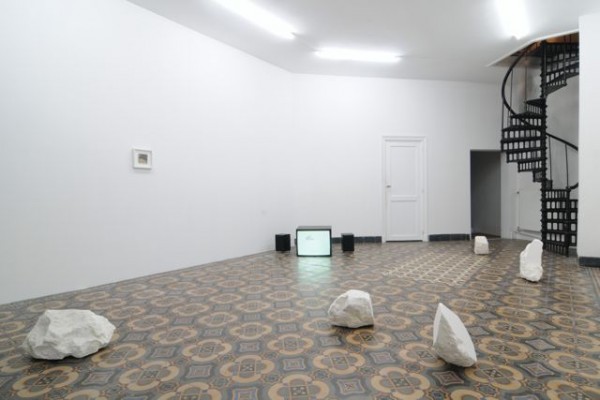Jesse Ash
Sunday, 11 March 2012
Work from The Sculptor’s Nightmare.
“…The ‘somewhere else’ you describe, could be thought of materially. I mean there are rules when you use a material like chalk, or editing software like Final Cut Pro and essentially you’re doing the same thing. Cutting away, re-modeling. And these rules and structures then impose their own restrictions to the content that may be taken from the ‘big outside’. In a sense, by materializing this information, I exert another filtering mechanism which abstracts it, and this abstraction is caused and affected by the processes which allow me—the author, but also just an individual in the world trying to closer to the already abstracted rhetoric of politics. It’s a document of proximity in a way.
…I use the context of the gallery space very particularly to stimulate tools that the audience already holds and that are necessary to uncover elements of the work—Scrutiny for example, and… as you say… time (although these are very much related). But also, I play with the sequential experience of works that might relate to each other. These could be seen as acts in a play or chapters in a book or something like that (to continue the use of heavy handed metaphors). Also, a viewer is often alone, and they have a shifting spatial relation to objects and images—i.e. as the feet move a sculpture changes shape, its image flipping from three dimensions to the effect of two—depending on the visual plane the spectator shares with the object. And while this is happening, the image on the wall becomes clearer, sharper as your proximity to it shifts. And then, the object is up close by the feet and you can look over it like a giant and simultaneously you can begin to see the construction of the image over there and the space within the image is opening up and out, so then we begin to have this very particular spatial, dimensional and temporal context with in which to show something to some one. A process of uncovering, which I think, resembles how we access the events, speeches, politics, conflicts that shape the world around us…
…The concept is made in a similar way to the chalk sculptures I’m working on now. An idea is a starting point where many questions are imposed upon it over a period of time… each question imposed on an idea is a test, and each test has an imagined outcome, which may work or fail as a result of that conceptual test. Like chipping away at something (this happens when anything continues to occupy the mind, I suppose). The ‘mental sculpture’ continues until there is a material starting point—when there is somewhere or something to start with. This might be an image for example, or a technique to impose upon a material, a sound to overlay with a colour or a model to be made. At this point the hand joins in. Both the mind and the hand impose new possibilities and problems upon each other and the variables and possibilities can often increase. This is the point when the work comes alive for me—when the hand, mind and material are working in relation to one another and something unpredictable is happening which I am beginning to loose control of despite my best efforts. I’m catching up, or running after the work…” – Jesse Ash


